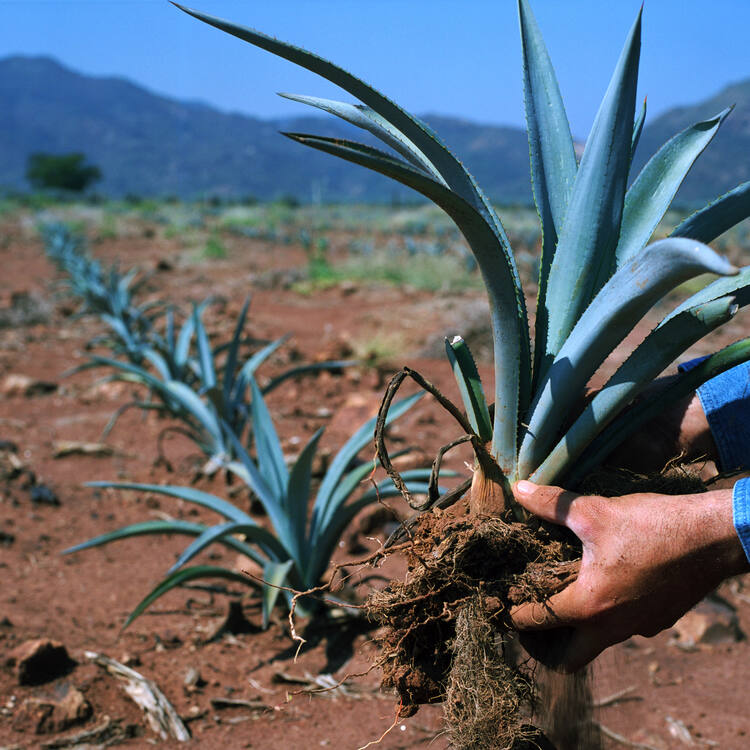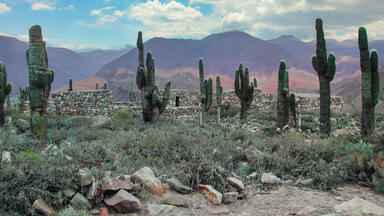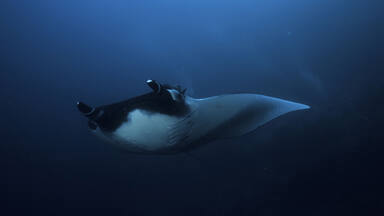Agave Landscape and Ancient Industrial Facilities of Tequila
Agave Landscape and Ancient Industrial Facilities of Tequila
The 34,658 ha site, between the foothills of the Tequila Volcano and the deep valley of the Rio Grande River, is part of an expansive landscape of blue agave, shaped by the culture of the plant used since the 16th century to produce tequila spirit and for at least 2,000 years to make fermented drinks and cloth. Within the landscape are working distilleries reflecting the growth in the international consumption of tequila in the 19th and 20th centuries. Today, the agave culture is seen as part of national identity. The area encloses a living, working landscape of blue agave fields and the urban settlements of Tequila, Arenal, and Amatitan with large distilleries where the agave ‘pineapple' is fermented and distilled. The property is also a testimony to the Teuchitlan cultures which shaped the Tequila area from AD 200-900, notably through the creation of terraces for agriculture, housing, temples, ceremonial mounds and ball courts.
Description is available under license CC-BY-SA IGO 3.0
Paysage d’agaves et anciennes installations industrielles de Tequila
Le site de 34 658 ha s’étend du pied du volcan Tequila jusqu’au canyon du Rio Grande. Il comprend de vastes paysages d’agaves bleues, façonnés par la culture de cette plante qui est utilisée depuis le XVIe siècle pour produire la tequila et depuis au moins 2 000 ans pour fabriquer des boissons fermentées et des textiles. On trouve dans ce paysage des distilleries en activité qui reflètent l’essor de la consommation internationale de tequila au XIXe et XXe siècles. Aujourd’hui, la culture de l’agave est considérée comme un élément intrinsèque de l’identité nationale mexicaine. La zone englobe un paysage vivant et exploité de champs d’agaves bleues et les peuplements urbains de Tequila, El Arenal et Amatitan, abritant de grandes distilleries où le cœur de l’agave (l’ananas) est fermenté et distillé. La zone comprend également des sites archéologiques qui contiennent des témoignages de la culture Teuchitlan qui a façonné la zone de Tequila de 200 à 900 apr. J.-C., notamment à travers la création de terrasses pour l’agriculture, d’habitations, de temples, de tertres cérémoniels et de terrains de jeu de balle.
Description is available under license CC-BY-SA IGO 3.0
مناظر الأغاف ومنشآت التكيلا الصناعية
يمتد الموقع على 658 34 هكتارًا من بركان تكيلا وصولاً إلى مفرج ريو غراندي. وهو يشمل مناظرَ طبيعيّة رحبة مكوّنة من نبتة الأغاف الزرقاء، علمًا أن المناظر نفسها تأثّرت عبر مرور الزمن بزراعة هذه النبتة المستخدمة منذ القرن السادس عشر لإنتاج مشروب التكيلا، ومنذ ألفي سنة على الأقل لصناعة المشروبات المختمرة والمنسوجات. نجد في هذا المنظر منشآت صناعة التقطير التي تعكس الازدهار الدولي للتكيلا في القرنَيْن التاسع عشر والعشرين. وتُعتبر زراعة الأغاف اليوم كعنصر ملازم للهوية الوطنية المكسيكية. كما أن المنطقة تشمل منظراً حيًّا لحقول الأغاف الزرقاء وسكان منطقة تكيلا، وإل أرينال، وأماتيتان التي تشهد صناعات التقطير، حيث يتمّ اختمار قلب الأغاف (الأناناس) وتقطيره. كما تحصي المنطقة مواقعَ أثريّةً تشهد على ثقافة توشيتلان التي تركت أثرها على منطقة التكيلا بأكملها، بدءاً من العام 200 حتى العام 900 ميلادي، بالأخص عبر استخدام المصطبة لأغراض زراعية، والمساكن، والمعابد، والتلال المخصصة للمراسم، والأراضي المخصصة للعب بالكرة.
مشهد طبيعي بلون التكيلا رسالة اليونسكو (2006)
source: UNESCO/CPE
Description is available under license CC-BY-SA IGO 3.0
龙舌兰景观和特基拉的古代工业设施
在特基拉火山脚和格兰德河河谷间有一个面积34 658公顷的遗址,它是广袤的蓝色龙舌兰生长地的一部分。这里因龙舌兰的种植而发生改变。自16世纪以来,人们就用这种植物生产龙舌兰酒。在过去的两千多年里,人们用它酿造各种饮料,并用来织布。该景观内有很多酿酒厂仍在生产,反映了19世纪和20世纪全世界龙舌兰酒消费量上升的趋势。现在种植龙舌兰已经成为墨西哥不可缺少的一部分。该遗址拥有一大片生机盎然的龙舌兰种植地,同时也是特基拉、阿雷纳和阿玛提坦城的城市聚落。很多大型酿酒厂在这里酿制和提取龙舌兰“菠萝”。列入《名录》的遗产包括龙舌兰种植地、酿酒厂、工厂(包括仍然开展生产的和已经停产的)、酒坊(西班牙统治时期的非法酿酒厂)、小镇和塔木西兰 考古遗址。遗产中还有很多农庄,即不动产,有些可以追溯到18世纪。工厂和农庄都是石砖和土砖结构,墙上涂有赭色石灰,建筑内有石拱、榫子和窗上装饰物,以及设计整齐的新古典主义风格或巴洛克风格的装饰品。这些建筑反映了前西班牙统治时期酿制龙舌兰酒的传统与欧洲提取工艺的融合,以及当地技术与从欧洲和美国引进的技术的融合。该遗产还包括见证塔栖兰文化的考古遗址。从公元200年到900年,特基拉地区就因塔栖兰文化的影响而发生了改变,主要表现在修造梯田以促进农业发展,建造房屋、庙宇和用于纪念仪式的土墩及球场。
source: UNESCO/CPE
Description is available under license CC-BY-SA IGO 3.0
Ландшафт плантаций агавы и старинные предприятия по производству текилы
Территория площадью 34 638 га между подножьем вулкана Текила и глубокой долиной реки Рио-Гранде является частью обширного ландшафта плантаций голубой агавы. Эта культура использовалась, начиная с XVI в., для производства текилового спирта и, по меньшей мере, в течение 2000 лет - для получения напитков брожения и изготовления тканей. В этот ландшафт входят действующие винокурни, что отражает рост потребления текилы в мире в XIX и XX вв. Сегодня культура агавы воспринимается, как часть национальной самобытности Мексики. Территория охватывает продолжающий жить и производить ландшафт плантаций голубой агавы и городские поселения Текила, Ареналь и Аматитан с крупными винокурнями, где «ананасы» агавы подвергаются брожению и возгонке. В составе объекта находятся: поля, винокурные предприятия т.н. «таверны» (небольшие винокурни, считавшиеся незаконными при власти испанцев), многочисленные гасиенды, или поместья, некоторые из которых относятся к XVIII в. Архитектура предприятий и гасиенд характерна сочетанием кирпичных и глинобитных конструкций, оштукатуренными стенами охристого цвета, каменными арками, отделкой, замковыми камнями окон, и строгой неоклассической или барочной орнаментацией. Объект отражает слияние доиспанских традиций забраживания сока мескаль и местных приемов возгонки, с технологическими процессами, заимствованными из Европы и США. Объект также включает археологические памятники, представляющие культуру Теучитлан, которая формировала район Текила с 200 по 900 гг. н.э., сооружая террасы для сельского хозяйства, жилищ, храмов, церемониальных возвышений и площадок для ритуальной игры в мяч.
source: UNESCO/CPE
Description is available under license CC-BY-SA IGO 3.0
Paisaje de agaves y antiguas instalaciones industriales de Tequila
Situado entre las estribaciones del volcán de Tequila y el profundo valle del Río Grande, este sitio se extiende por una superficie de 34.658 hectáreas y forma parte de un vasto paisaje de cultivos de agave azul, una planta que se viene usando desde el siglo XVI para elaborar la tequila y, desde hace 2.000 años por lo menos, para producir bebidas fermentadas y confeccionar ropa gracias a sus fibras textiles. Dentro de esta zona paisajística están en actividad las destilerías de tequila, que son un exponente del aumento del consumo internacional de esta bebida alcohólica a lo largo de los siglos XIX y XX. Hoy en día, se considera que el cultivo del agave es un elemento intrínseco de la identidad nacional mexicana. El sitio comprende el paisaje configurado por los campos donde se cultiva el agave azul y los asentamientos urbanos de Tequila, Arenal y Amatitlán, que poseen grandes destilerías donde se fermenta la piña de la planta para fabricar el alcohol. También comprende zonas de vestigios arqueológicos de cultivos en terrazas, viviendas, templos, túmulos ceremoniales y terrenos de juego de pelota que constituyen un testimonio de la cultura de Teuchitlán, predominante en la región de Tequila entre los años 200 y 900 de nuestra era.
source: UNESCO/CPE
Description is available under license CC-BY-SA IGO 3.0
リュウゼツラン景観と古代テキーラ産業施設群
メキシコ中西部、テキーラ火山のふもとからリオ・グランデ川の渓谷の間にある346.58k㎡の地域には、蒸留酒テキーラの原料となるアオノリュウゼツランの耕地が広がる。この地では、約2000年以上前からアオノリュウゼツランを原料に、発酵飲料や織物が作られ、現在ではメキシコを特徴づける文化となっている。テキーラ製造は16世紀に始まり、19~20世紀に世界中で愛飲されるようになったため、蒸留所の数が増えた。蒸留所の多くは干しレンガで造られ、バロック様式の装飾を特徴とする。世界遺産には、2~9世紀にかけて一帯で栄えた、テウティトラン文明の遺跡も含まれる。source: NFUAJ
Agave-landschap en oude industriële faciliteiten van Tequila
Dit gebied van 34.658 hectare ligt tussen de uitlopers van de Tequila vulkaan en de diepe vallei van de Rio Grande rivier. Het is onderdeel van een uitgestrekt landschap vol velden blauwe agave, de plant die vanaf de 16e eeuw gebruikt is voor tequila en al 2.000 jaar gebruikt wordt om gegiste dranken en stoffen te maken. In het gebied liggen de nederzettingen Tequila, Arenal en Amatitan met grote distilleerderijen waar de agave 'ananas' wordt gefermenteerd en gedistilleerd. Ze weerspiegelen de groei van de internationale consumptie van tequila in de 19e en 20e eeuw. Tegenwoordig beschouwt men de agave-cultuur als onderdeel van de nationale identiteit.
Source: unesco.nl
Outstanding Universal Value
Brief Synthesis
The Agave Region, in the Valles Region of the Jalisco State, is one of the most important cultural landscapes in Mexico, not only for the importance of the natural landscape that offers, but for the cultural tradition that has kept for several centuries and from which has arisen one of the main icons that identify this country: the tequila.
The 35,019 ha site, between the foothills of the Tequila Volcano and the deep valley of the Rio Grande River, is part of an expansive landscape of blue agave, shaped by the culture of the plant used since the 16th century to produce tequila spirit and for at least 2,000 years to make fermented drinks and cloth. Within the landscape are working distilleries reflecting the growth in the international consumption of tequila in the 19th and 20th centuries. Today, the agave culture is seen as part of national identity. The area encloses a living, working landscape of blue agave fields and the urban settlements of Tequila, Arenal, and Amatitan with large distilleries where the agave ‘pineapple' is fermented and distilled. The property is also a testimony to the Teuchitlan cultures which shaped the Tequila area from AD 200-900, notably through the creation of terraces for agriculture, housing, temples, ceremonial mounds and ball courts.
Criterion (ii): The cultivation of agave and its distillation have produced a distinctive landscape within which are a collection of fine haciendas and distilleries that reflect both the fusion of pre-Hispanic traditions of fermenting mescal juice with the European distillation processes and of local and imported technologies, both European and American.
Criterion (iv): The collection of haciendas and distilleries, in many cases complete with their equipment and reflecting the growth of tequila distillation over the past two hundred and fifty years, are together an outstanding example of distinct architectural complexes which illustrate the fusion of technologies and cultures.
Criterion (v): The agave landscape exemplified the continuous link between ancient Mesoamerican culture of the agave and today, as well as the contours process of cultivation since the 17th century when large scale plantations were created and distilleries first started production of tequila. The overall landscape of fields, distilleries, haciendas and towns is an outstanding example of a traditional human settlement and land-use which is representative of a specific culture that developed in Tequila.
Criterion (vi): The Tequila landscape has generated literary works, films, music, art and dance, all celebrating the links between Mexico and tequila and its heartland in Jalisco. The Tequila landscape is thus strongly associated with perceptions of cultural significances far beyond its boundaries.
Integrity
The World Heritage property is large and encompasses the whole of the core of tequila growing landscape and most of the related elements and interdependent that characterizes the agave region. The area also includes all aspects of the tequila growing and distillation process, and the haciendas and factories and associated towns, thus encompassing an economic and cultural area.
In the municipalities of Magdalena, Tequila, Amatitán and El Arenal concentrate the tangible and intangible testimonies of different historical periods that favour the comprehension and appreciation as a whole coherent and vital. The inscribed property is the region of origin of the cultural process and therefore the one that better exemplifies its historical development.
The extension deployed on the municipalities of El Arenal, Amatitán, Tequila and Magdalena embraces a valley with geographical and agricultural continuity where most of the tangible elements of the occupation of the territory are located, represented by the archaeological vestiges, plantations and industrial facilities as well as the intangible ones, represented by practices and customs of the community that inhabits the region. They have been the support of the cultural process of the production of Tequila. These same elements can propitiate their long term conservation and their sustainable development. To the date, significant problems produced by the human activity that could commit the integrity of the site have not occurred.
Authenticity
In terms of the cultivated landscape, haciendas, distilleries and the centres of the urban settlements, there is no doubt of their authenticity as reflecting the way the landscape has been used and still is to grow and process the agave plant and distil tequila. The methods of cultivation and processing both retain their authenticity and there is still a defined link between where the agave plants grow and the distilleries to which they are sent: only tequila processed from agave pineapples grown in the inscribed property is eligible for a Declaration of Origin. The work in the agricultural field attests the survival of essential elements that have shaped the agave landscape from its creation and the continuity of an ancient cultural process.
The extensive cultivations and the old distilleries of the region of Tequila have a strong character of syncretism since in them fuse ancestral knowledge of the American and European traditions. The hefty character of the landscape is the result of the cultivation and domestication of the Agave Azul Tequilana Weber native plant of the region, through a long journey along the time. From it comes the genus loci that impregnates the site in a single way. It is characterized by countless undulant lines of agave that adapt to the irregular topography of the region. The outskirts of the urban areas have been subject to recent development and change and there is less well defined local building traditions and authenticity. In these areas positive programmes will be needed to manage change in a beneficial way. The Management Plan addresses this need.
Protection and management requirements
About 22% of the nominated area is owned privately; 44% is common land; the remainder, 34% is what is called mixed productive associations which are private investment on common land. Most of the factories still in production are in urban areas. Those in rural areas belong to private owners. Altogether there are 60 factories in the inscribed property.
Legal protection applies at Federal, State and Municipal levels. At the Federal level, there are different legal tools that pertain to the Tequila product itself, while heritage protection is granted through the 1972 Federal Law Regarding Artistic, Historical and Archaeological Monuments and Sites, the General Law in Human Settlements and the General Law of National Properties, the General Law of Ecological Balance and Environmental Protection. With these tools, federal protection applies to historical monuments before the 20th century, designated towns and villages, archaeological and industrial sites and the relationship between natural sites and cultural ones. This covers the core of the towns and nominated factories and haciendas. At the State Level, the Law of the Cultural Patrimony of the State of Jalisco and Municipalities, the Regulations for the Cultural Patrimony of the State of Jalisco and Municipalities, the Law of Urban Development of the State of Jalisco, the Decrees of Natural Protection Areas, are tools to ensure the preservation of both cultural and natural patrimony and people’s culture. The State has responsibility for the preservation and restoration of historical, architectural and archaeological sites, urban and territorial development and the delineation of settlements. In particular it is responsible for the protected Tequila landscape through the Tequila Master Plan. Finally, at the Municipal level, the Regulations for the Protection and Improvement of the Urban Image of Tequila, Jalisco, the Partial Plan of Urban Development on the Historical Centre of Tequila, Jalisco, the Partial Plan of Urban Development for the Conservation of the Urban and Architectural Patrimony of the Historical Centre of Amatitán, Jalisco, the Plan of Urban Development of the El Arenal, Jalisco, the Model of Territorial Ecological Classification of the State of Jalisco, Region Valles, provide control over 20th and 21st century heritage building at the property.
The Management Plan for the Agave Landscape and the Ancient Facilities of Tequila is the main management and planning tool. Its implantation is centred on improving the quality of life of the inhabitant communities and to act as factor of integration of the diverse effective legal instruments and competent instances in the region. It also seeks to ensure that the conditions of authenticity and integrity of each one of the components of the Agave Landscape are maintained through its conservation, restoration and appropriate use. Likewise, it strives to stimulate a sustainable regional growth supported by the local cultural values. The implementation of the management plan sets out the provisions for the conservation and sustainable use of the ensemble of attributes of the property: the natural landscape, the agave landscape, the archaeological vestiges, the ancient industrial facilities and the traditional towns. It is also a tool to promote that the social sectors of less economic income are contemplated as high-priority groups for the benefits derived from the rescue and conservation of the Cultural Agave Landscape. As part of the strategy followed by the Instituto Nacional de Antropología e Historia and State Government of Jalisco to ensure the conservation and protection of the property through the sustainable regional development of the entity, the “Agave Landscape of Tequila” has been incorporated as a “Strategic Project for the development of Jalisco”.


